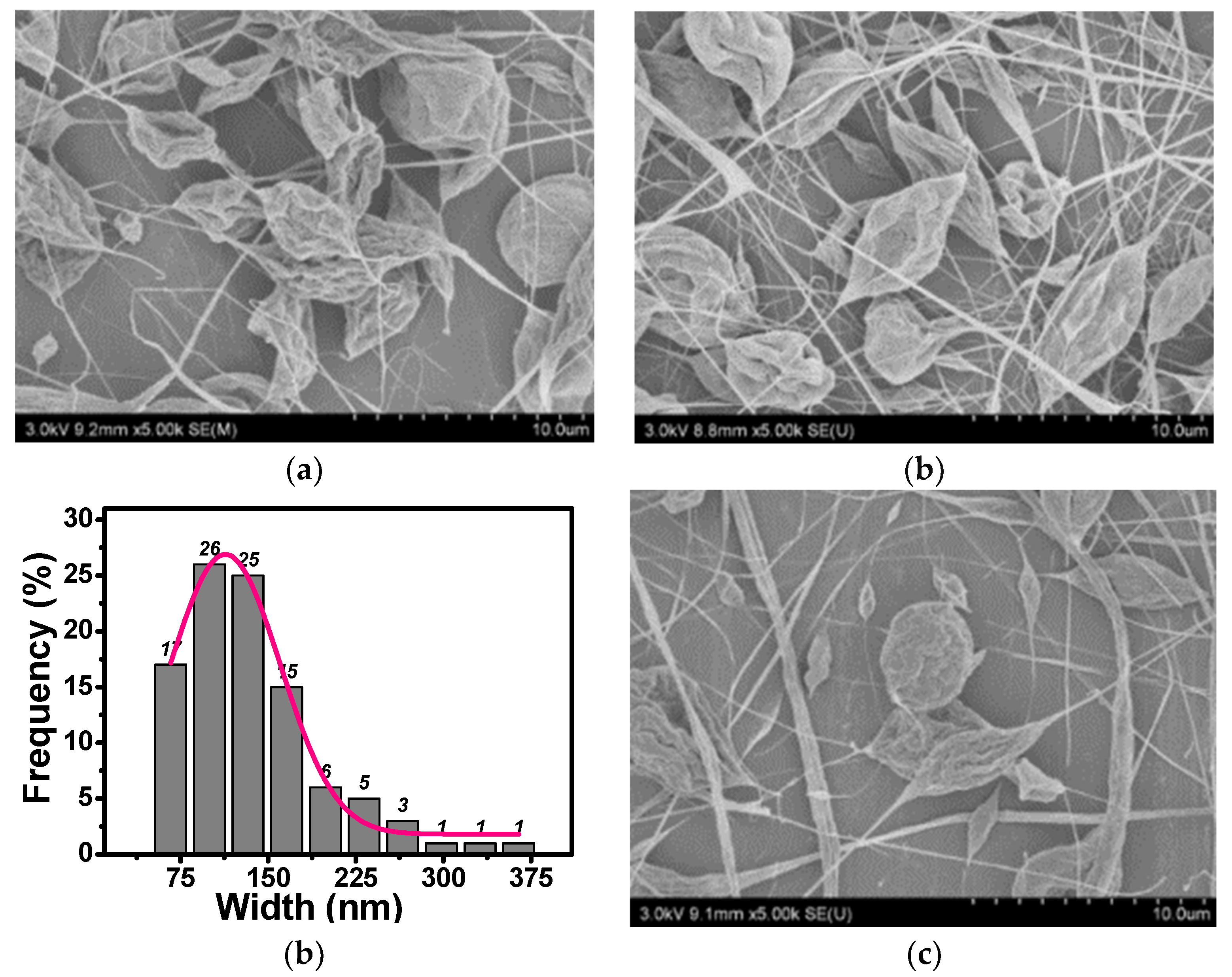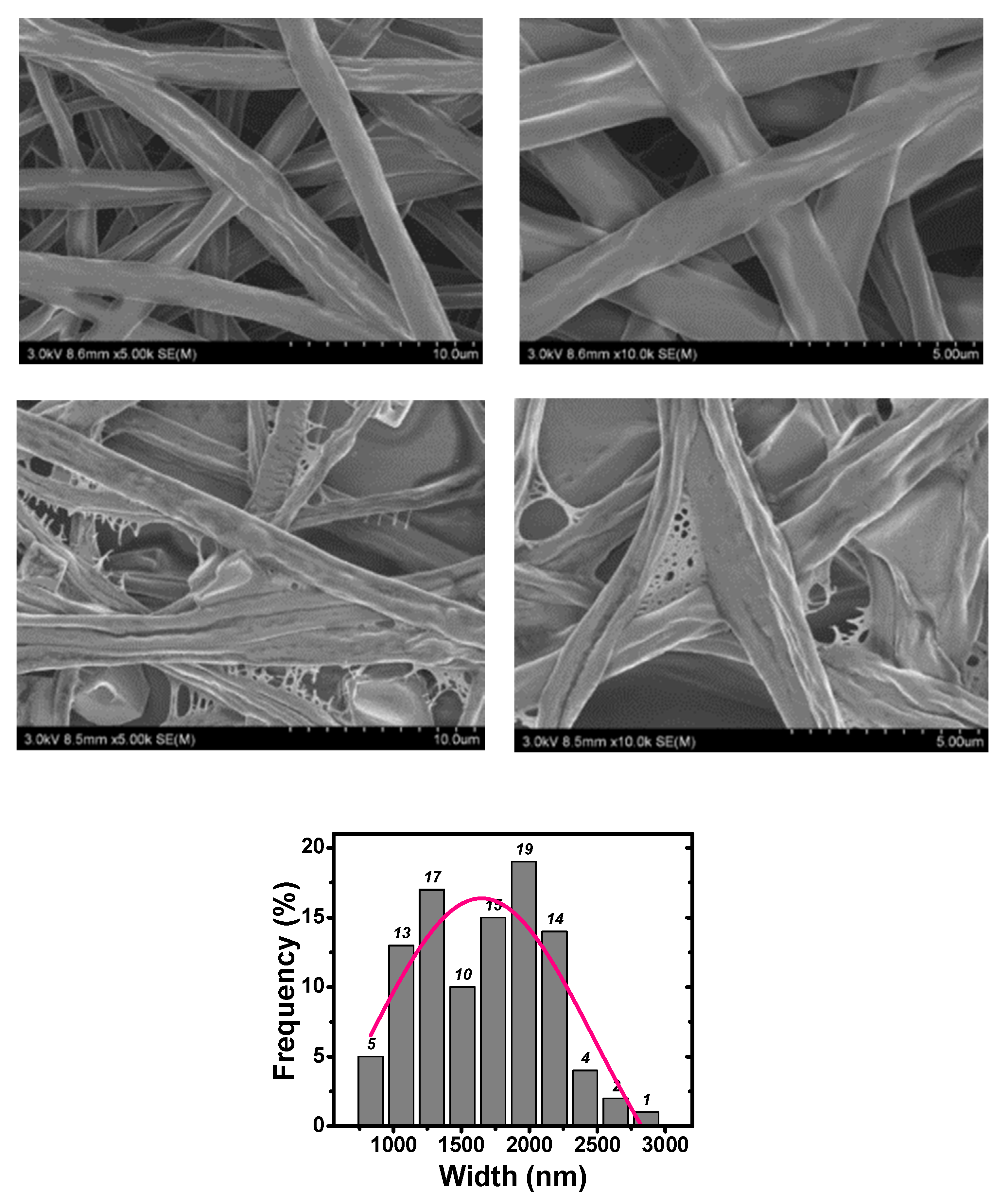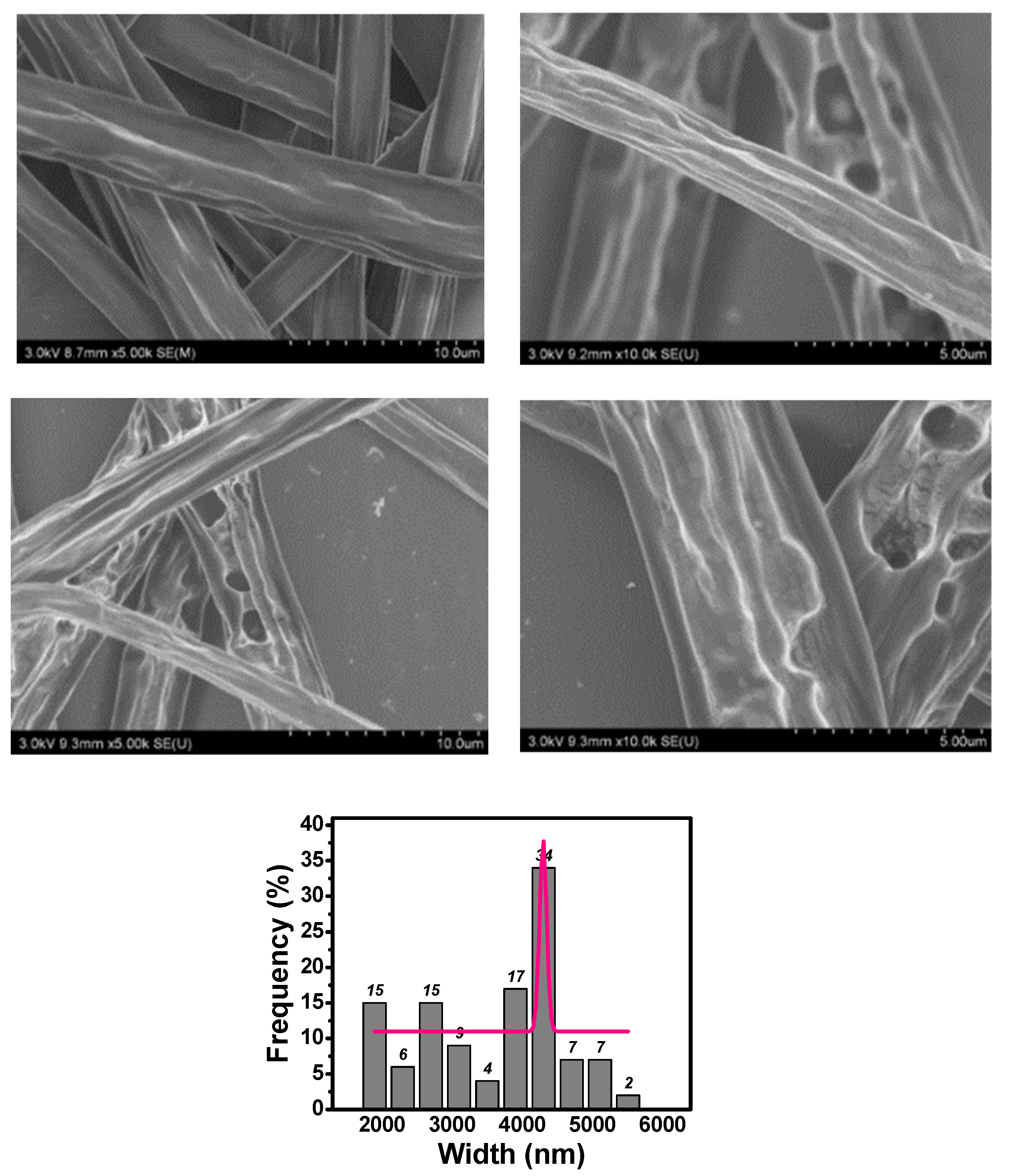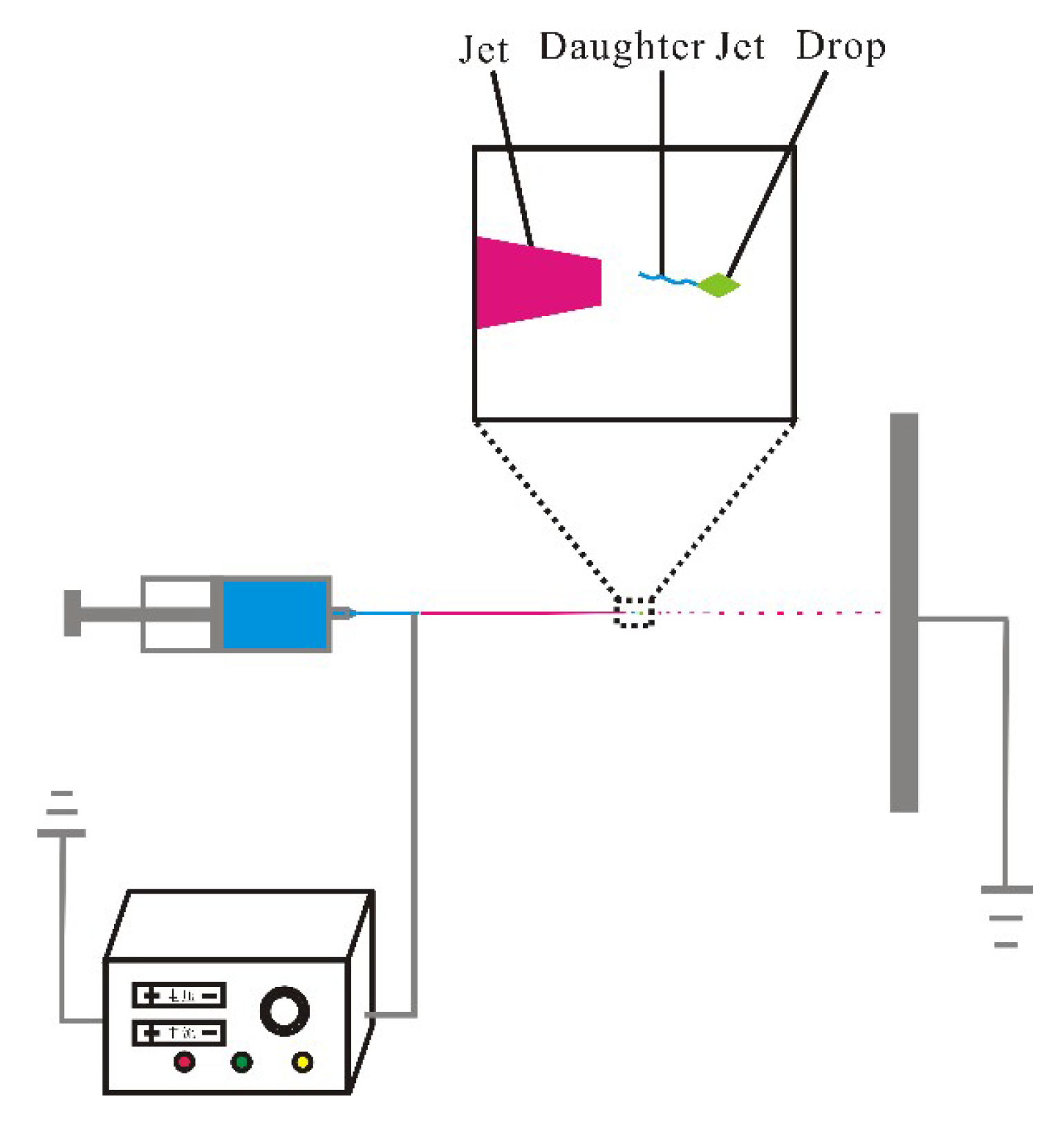Fabrication of Beltlike Fibers by Electrospinning
Abstract
:1. Introduction
2. Taylor Cone
3. Minimal Surface vs. Hall–Petch Effect
4. Experiment Design
5. Results and Discussion
6. Conclusions
Author Contributions
Funding
Acknowledgments
Conflicts of Interest
References
- Yu, L.; Shao, Z.B.; Xu, L.; Wang, M.D. High throughput preparation of aligned nanofibers using an improved bubble-electrospinning. Polymers 2017, 9, 658. [Google Scholar] [CrossRef]
- Song, Y.H.; Sun, Z.Y.; Xu, L.; Shao, Z.B. Preparation and characterization of highly aligned carbon nanotubes/polyacrylonitrile composite nanofibers. Polymers 2017, 9, 1. [Google Scholar] [CrossRef]
- Liu, Y.Q.; Feng, J.W.; Zhang, C.C.; Teng, Y.; Liu, Z.; He, J.H. Air permeability of nanofiber membrane with hierarchical structure. Therm. Sci. 2018, 22, 1637–1643. [Google Scholar] [CrossRef]
- He, J.H.; Kong, H.Y.; Yang, R.R.; Dou, H.; Faraz, N.; Wang, L.; Feng, C. Review on fiber morphology obtained by the bubble electrospinning and blown bubble spinning. Therm. Sci. 2012, 16, 1263–1279. [Google Scholar] [CrossRef]
- Yu, D.N.; Tian, D.; He, J.H. Snail-based nanofibers. Mater. Lett. 2018, 220, 5–7. [Google Scholar] [CrossRef]
- Liu, P.; He, J.H. Geometrical potential: An explanation on of nanofibers wettability. Therm. Sci. 2018, 22, 33–38. [Google Scholar] [CrossRef]
- Liu, L.G.; He, J.H. Solvent evaporation in a binary solvent system for controllable fabrication of porous fibers by electrospinning. Therm. Sci. 2017, 21, 1821–1825. [Google Scholar] [CrossRef]
- Fan, C.X.; Sun, Z.Y.; Xu, L. Fluid-mechanic model for fabrication of nanoporous fibers by electrospinning. Therm. Sci. 2017, 21, 1621–1625. [Google Scholar] [CrossRef]
- Liu, Y.Q.; Zhao, L.; He, J.H. Nanoscale multi-phase flow and its application to control nanofiber diameter. Therm. Sci. 2018, 22, 43–46. [Google Scholar] [CrossRef]
- Shao, Z.B.; Song, Y.H.; Xu, L. Formation mechanism of highly aligned nanofibers by a modified bubble ectrospinning. Therm. Sci. 2018, 22, 5–10. [Google Scholar] [CrossRef]
- Ren, Z.F.; Kong, F.Z.; Wang, F.Y.; Hu, G.F. Effect of bubble size on nanofiber diameter in bubble electrospinning. Therm. Sci. 2016, 20, 845–848. [Google Scholar] [CrossRef]
- Wang, F.Y.; He, J.H.; Sun, Q.L.; Yu, J. Improvement of air permeability of Bubbfil nanofiber membrane. Therm. Sci. 2018, 22, 17–21. [Google Scholar] [CrossRef]
- Sun, H.Y.; Zhu, W.Y. Co3O4 mirobelts: Preparation with the electrospinning technique and its investigation in peroxidase-like activity. Appl. Surf. Sci. 2017, 399, 298–304. [Google Scholar] [CrossRef]
- Yang, G.R.; Wang, L.; Wang, J.N.; Yan, W. Fabrication and formation mechanism of Li2MnO3 ultrathin porous nanobelts by electrospinning. Ceram. Int. 2017, 43, 71–76. [Google Scholar] [CrossRef]
- Xu, W.H.; Ding, Y.C.; Yang, T.; Yu, Y.; Huang, R.Z.; Zhu, Z.T.; Fong, H.; Hou, H.Q. An innovative approach for the preparation of high-performance electrospun poly(p-phenylene)-based polymer nanofiber belts. Macromolecules 2017, 50, 9760–9772. [Google Scholar] [CrossRef]
- Lu, Y.; Xiao, X.D.; Cao, Z.Y.; Zhan, Y.J.; Cheng, H.L.; Xu, G. Transparent optically vanadium dioxide thermochromic smart film fabricated via electrospinning technique. Appl. Surf. Sci. 2017, 425, 233–240. [Google Scholar] [CrossRef]
- Liu, Z.D.; Lu, Q.F.; Wei, M.Z.; Guo, E.Y. FeVO4 nanobelts: Controllable synthesis by electrospinningand visible-light photocatalytic properties. J. Sol-Gel Sci. Technol. 2017, 82, 67–74. [Google Scholar] [CrossRef]
- Liu, Z.; Sun, Q.L.; He, J.H. Fabrication of unsmooth bamboo-like nanofibers. Therm. Sci. 2015, 19, 1450–1451. [Google Scholar] [CrossRef]
- Chen, R.X.; Zhang, L.I.; Kong, H.Y.; He, J.H.; Chen, Y. Mechanism of nanofiber crimp. Therm. Sci. 2013, 17, 1473–1477. [Google Scholar] [CrossRef]
- Huang, J.X.; Li, H.F.; Song, M.F.; Chen, R.X.; Wang, P.; He, J.H. Effect of temperature on nonlinear dynamical property of stuff box crimping and bubble electrospinning. Therm. Sci. 2014, 18, 1049–1053. [Google Scholar] [CrossRef]
- Rana, D.; Mandal, B.M.; Bhattacharyya, S.N. Analogue calorimetric studies of blends of poly(vinyl ester)s and polyacrylates. Macromolecules 1996, 29, 1579–1583. [Google Scholar] [CrossRef]
- Rana, D.; Mandal, B.M.; Bhattacharyya, S.N. Analogue calorimetry of polymer blends: Poly(styrene-co-acrylonitrile) and poly(phenyl acrylate) or poly(vinyl benzoate). Polymer 1996, 37, 2439–2443. [Google Scholar] [CrossRef]
- Rana, D.; Mandal, B.M.; Bhattacharyya, S.N. Miscibility and phase-diagrams of poly(phenyl acrylate) and poly(styrene-co-acrylonitrile) blends. Polymer 1993, 34, 1454–1459. [Google Scholar] [CrossRef]
- Lowman, A.M.; Cowans, B.A.; Peppas, N.A. Investigation of interpolymer complexation in swollen polyelectolyte networks using solid-state NMR spectroscopy. J. Polym. Sci. Polym. Phys. Ed. 2000, 38, 369–375. [Google Scholar] [CrossRef]
- Efome, J.E.; Rana, D.; Matsuura, T.; Lan, C.Q. Metal-organic frameworks supported on nanofibers to remove heavy metals. J. Mater. Chem. A 2018, 6, 4550–4555. [Google Scholar] [CrossRef]
- Efome, J.E.; Rana, D.; Matsuura, T.; Lan, C.Q. Insight studies on metal-organic framework nanofibrous membrane adsorption and activation for heavy metal ion removal from aqueous solution. ACS Appl. Mater. Interfaces 2018, 10, 18619–18629. [Google Scholar] [CrossRef] [PubMed]
- Efome, J.E.; Rana, D.; Matsuura, T.; Lan, C.Q. Experiment and modeling for flux and permeate concentration of heavy metal ion in adsorptive membrane filtration using a metal-organic framework incorporated nanofibrous membrane. Chem. Eng. J. 2018, 352, 737–744. [Google Scholar] [CrossRef]
- Xu, W.W.; Davila, L.P. Tensile nanomechanics and the Hall-Petch effect in nanocrystalline aluminium. Mater. Sci. Eng. A Struct. 2018, 710, 413–418. [Google Scholar] [CrossRef] [Green Version]
- He, J.H.; Wan, Y.Q.; Xu, L. Nano-effects, quantum-like properties in electrospun nanofibers. Chaos Solitons Fractals 2007, 33, 26–37. [Google Scholar] [CrossRef]
- Tian, D.; Zhou, C.J.; He, J.H. Strength of bubble walls and the Hall-Petch effect in bubble-spinning. Text. Res. J. 2018. [Google Scholar] [CrossRef]
- Tian, D.; Li, X.X.; He, J.H. Self-assembly of macromolecules in a long and narrow tube. Therm. Sci. 2018, 22, 1659–1664. [Google Scholar] [CrossRef]
- Tian, D.; Zhou, C.J.; He, J.H. Hall-Petch effect and inverse Hall-Petch effect: A fractal unification. Fractals 2018. [Google Scholar] [CrossRef]
- Hou, X.B.; Cai, Y.B.; Mushtaq, M.; Song, X.; Yang, Q.; Huang, F.; Wei, Q. Deposition of TiO2 nanoparticles on porous polylactic acidfibrous substrates and its photocatalytic capability. J. Nanosci. Nanotechnol. 2018, 18, 5617–5623. [Google Scholar] [CrossRef] [PubMed]
- Swaroop, C.; Shukla, M. Nano-magnesium oxide reinforced polylactic acid biofilms for food packaging applications. Int. J. Biol. Macromol. 2018, 113, 729–736. [Google Scholar] [CrossRef] [PubMed]
- Kuznetsova, I.N.; Blaskov, V.; Znaidi, L. Study on the influence of heat treatment on the crystallographic phases of nanostructured TiO2 films. Mater. Sci. Eng. B Adv. 2007, 137, 31–39. [Google Scholar] [CrossRef]
- Gupta, V.; Tyagi, S.; Paul, A.K. Surface modification of nanoscale iron carboxylate metal organic framework with polyethylene glycol. Integr. Ferroelectr. 2017, 184, 129–134. [Google Scholar] [CrossRef]





| Solution Sample | PLA (g) | Dichloromethane (DCM) (g) | Dimethyl Acetamide (DMAC) (g) | Polyethylene Glycol (PEG) (g) | ZrO2 (g) | Concentration (%) |
|---|---|---|---|---|---|---|
| A | 0.4 | 17.64 | 1.96 | 0 | 0 | 2% |
| B | 0.4 | 17.64 | 1.96 | 2 | 0 | 2% |
| C | 1 | 15.57 | 1.73 | 2 | 0.2 | 5% |
| Samples | Voltage (kV) | Receptor’s Distance (cm) | Solution Supply Ratio (mL/h) | Solution Sample | Belt Width (nm) |
|---|---|---|---|---|---|
| 1 | 15 | 17 | 0.1 | A | - |
| 2 | 15 | 17 | 0.2 | A | 137.59 ± 11.91 |
| 3 | 17 | 17 | 0.1 | A | - |
| 4 | 15 | 17 | 0.2 | B | 1657 ± 92.86 |
| 5 | 20 | 17 | 0.2 | C | 3493 ± 208.41 |
© 2018 by the authors. Licensee MDPI, Basel, Switzerland. This article is an open access article distributed under the terms and conditions of the Creative Commons Attribution (CC BY) license (http://creativecommons.org/licenses/by/4.0/).
Share and Cite
Liu, Y.-Q.; He, C.-H.; Li, X.-X.; He, J.-H. Fabrication of Beltlike Fibers by Electrospinning. Polymers 2018, 10, 1087. https://doi.org/10.3390/polym10101087
Liu Y-Q, He C-H, Li X-X, He J-H. Fabrication of Beltlike Fibers by Electrospinning. Polymers. 2018; 10(10):1087. https://doi.org/10.3390/polym10101087
Chicago/Turabian StyleLiu, Yan-Qing, Chun-Hui He, Xiao-Xia Li, and Ji-Huan He. 2018. "Fabrication of Beltlike Fibers by Electrospinning" Polymers 10, no. 10: 1087. https://doi.org/10.3390/polym10101087
APA StyleLiu, Y.-Q., He, C.-H., Li, X.-X., & He, J.-H. (2018). Fabrication of Beltlike Fibers by Electrospinning. Polymers, 10(10), 1087. https://doi.org/10.3390/polym10101087






